The Eifelian
The Eifelian Age of the Middle Devonian Epoch: 398 to 392 million years ago
Geography
 As always, when we are forced to use home-made graphics, the reader may correctly assume that there is something terribly wrong with the state of real knowledge in the area. There is no lack of Middle Devonian maps, but the degree of correspondence between them is extraordinarily poor. The basic facts of North American (Laurentian) and North European (Baltican) geography are well known. However, the position of the other continents, and the degree to which they lay above sea level, seems to be the subject of considerable dispute. We have therefore drawn a sort of compromise map. We strongly discourage anyone from taking it very seriously.
As always, when we are forced to use home-made graphics, the reader may correctly assume that there is something terribly wrong with the state of real knowledge in the area. There is no lack of Middle Devonian maps, but the degree of correspondence between them is extraordinarily poor. The basic facts of North American (Laurentian) and North European (Baltican) geography are well known. However, the position of the other continents, and the degree to which they lay above sea level, seems to be the subject of considerable dispute. We have therefore drawn a sort of compromise map. We strongly discourage anyone from taking it very seriously.
In North America, the Acadian Orogeny [1]was at or near its end. The mountains in the east and south probably stood as tall as they ever would -- perhaps as tall as the Andes today -- but volcanic activity was almost at an end. In the west, volcanic island arcs continued to form and accrete to the North American craton, although this process, too was nearing its end. North of Laurentia, a series of relatively small land masses were created between Laurentia and Siberia, including parts of the Canadian Arctic and Alaska's North Slope.
The European side of Laurasia (Laurentia plus Baltica) was more active, and the Caledonian belt, running between Greenland and Scotland was periodically quite active. Nevertheless, much of this activity was due to the gradual counterclockwise rotation of Laurentia away from Baltica, so this was an extensional, not collisional, process. With the gradual subsidence of mountain- building and marginal subduction in northern and eastern Laurasia, erosion created vast new beds of sediment -- the famous "Old Red Continent" sediments of this area which have done so much for Late Paleozoic paleontology.
In the vast southern continent of Gondwana, South America continued its slow clockwise rotation, gradually closing the Phobic Sea. There is some evidence for a medium- sized bolide strike in the area of the Rheic Ocean towards the end of the Eifelian. However, if this occurred, the effects were relatively short-lived. Eastern Gondwana was relatively flat, and the Paleotethys was shallow as well, to judge by the extensive carbonate sediments of this age. This feature may well have created a broad migrational highway for East Gondwanan marine and freshwater species to spread westward. Certainly the endemism of Early Devonian vertebrate life begins to break down during the Eifelian.
Notes: [1]A recent valiant, but probably futile attempt to standardize the nomenclature of this series of mountain-building events has been made by McKerrow et al. (2000). ATW030405.
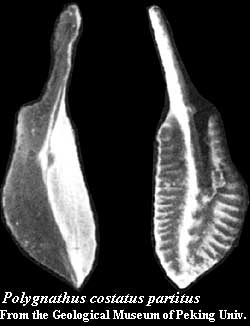 The most recent ICS date for the beginning of the Eifelian is 397.5 ± 2.7 Mya. As with all of the Devonian stages, the error margins are rather high. The base of the Eifelian is defined by its Global Stratotype Section and Point (GSSP): the first appearance of the conodont subspecies Polygnathus costatus partitus in the Wetteldorf Richtschnitt, near the town of Schönecken-Wetteldorf, in the Eifel Hills of Germany, a bit southwest of Bonn. At the time, this was near the south coast of the continent of Baltica -- but not for long. The islands of Armorica were finishing their fast passage of the Rheic Ocean from Gondwana and were about to collide with Baltica, eventually forming parts of present-day central and southern Europe. The base of the Eifelian is associated with a major faunal turnover in many sections, for reasons which are not known.
The most recent ICS date for the beginning of the Eifelian is 397.5 ± 2.7 Mya. As with all of the Devonian stages, the error margins are rather high. The base of the Eifelian is defined by its Global Stratotype Section and Point (GSSP): the first appearance of the conodont subspecies Polygnathus costatus partitus in the Wetteldorf Richtschnitt, near the town of Schönecken-Wetteldorf, in the Eifel Hills of Germany, a bit southwest of Bonn. At the time, this was near the south coast of the continent of Baltica -- but not for long. The islands of Armorica were finishing their fast passage of the Rheic Ocean from Gondwana and were about to collide with Baltica, eventually forming parts of present-day central and southern Europe. The base of the Eifelian is associated with a major faunal turnover in many sections, for reasons which are not known.
A parastratotype section is located in a quarry near Prague, Czech Republic. The Eifelian is the same as the Couvinian Age of older European nomenclature. The base of the Eifelian (but not its end) also coincides with the Chinese Yingtangian Age, which is also defined by reference to P.c. partitus.
Conodonts: Conodonts are the mainstay of Eifelian stratigraphy. Commonly used conodonts (with zone indicator species noted) include the distinctive conodont Icriodus corniger retrodepressus which follows P.c. partitus (partitus Zone) closely in time. Another early arrival is P. ziegleranus. The middle of the Eifelian is marked by P.c. costatus (costatus Zone) and P. australis australis Zone). Toward the end of the Age, elements of Tortodus kockelianus kockelianus (kockelianus Zone), P. ensensis (ensensis Zone), and P. xylus are found in that order. Pyle et al. (2003).
Ammonoids: One web source summarizes an ammonoid goniatite) zonation scheme for North Africa as follows: Foordites veniens to Pinacites jugleri Unit (partitus to earliest costatus Zones; Pinacites jugleri (early costatus Zone); Subanarcestes macrocephalus and Cabrieroceras 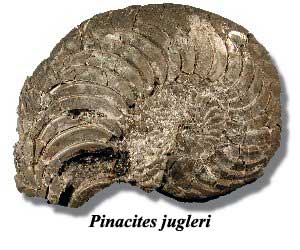 crispiforme Unit (early to middle costatus Zone) Cabrieroceras housei Unit (middle to late costatus Zone); Agoniatites vanuxemi, Parodiceras magnosellaris, and A. obliquus Unit latest costatus to ?eiflius Zone); Holzapfeloceras circumflexiferum Unit (ensensis to the Givetian timorensis Zones). Klug, Christian- Quantitative stratigraphy and taxonomy of late ... See also, the section on ammonoids below.
crispiforme Unit (early to middle costatus Zone) Cabrieroceras housei Unit (middle to late costatus Zone); Agoniatites vanuxemi, Parodiceras magnosellaris, and A. obliquus Unit latest costatus to ?eiflius Zone); Holzapfeloceras circumflexiferum Unit (ensensis to the Givetian timorensis Zones). Klug, Christian- Quantitative stratigraphy and taxonomy of late ... See also, the section on ammonoids below.
Corals: Tabulate corals do not appear to give much stratigraphic resolution. However, they have been used in Eastern Europe for some purposes. So, for example, Cyathophyllum dianthus and Thamnophyllum caespitosum are said to be indicative of the Eifelian and lowermost Givetian of Slovakia. Biostratigraphy and rugose corals of Moravian Devonian ... But this does not seem to correlate even with the Eifelian corals next door in the Czech Republic. Spacek et al. 2002).
Trilobites: Undoubtedly, someone has a good trilobite zonation scheme for the Eifelian. However, we were only able to uncover general agreement that Phacops latifrons is associated with the Early Eifelian.
Vertebrates: Asterolepis appears all over the world during the Eifelian, and is a good indicator to that extent. However, it apparently has no greater resolution. Other placoderms have notoriously endemic distribution and appearance. Stratigraphic occurrence of some placoderm fishes 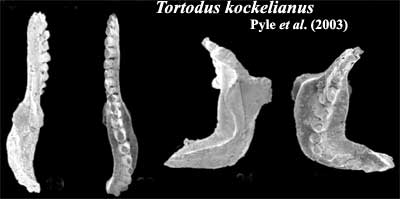 in the Middle .... It has been reported, based on as-yet unpublished data, that the acanthodian Diplacanthus solidus is indicative of Eifelian age. Mannik et al. (2002).
in the Middle .... It has been reported, based on as-yet unpublished data, that the acanthodian Diplacanthus solidus is indicative of Eifelian age. Mannik et al. (2002).
Strata: As is typical of Devonian sediments, it is possible to make some reasonably good correlations of strata across the Atlantic, for the obvious reason that there was no Atlantic in Devonian times. In the Late Emsian, crinoid-bearing carbonates indicative of shallower waters are found in "normally" deeper water areas, suggesting that the Eifelian began with unusually low sea levels. Sea levels apparently increased to a highstand in the upper kockelianus Zone which was associated with black shales, organic-rich sediments, and other indications of ocean anoxia.
Gamma Rays and Man-in-the-Moon Marigolds: In recent years there has been a serious attempt to use gamma ray spectroscopy, magnetosusceptibility (MSEC), and zircon fission track analysis, among other very high tech approaches to 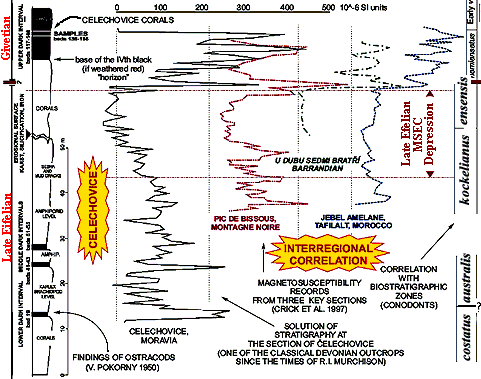 Paleozoicstratigraphy. The idea is not quite as crack-pot as is sounds, and some results have been amazingly good, or at least highly reproducible (unlike electron thermoluminescence, which had a brief, but disastrous, influence on some Neogene dating schemes).
Paleozoicstratigraphy. The idea is not quite as crack-pot as is sounds, and some results have been amazingly good, or at least highly reproducible (unlike electron thermoluminescence, which had a brief, but disastrous, influence on some Neogene dating schemes).
The utility of MSEC and these other methods is based on the fact that carbonate sediments have effectively zero ability to be magnetized by strong external magnetic fields and contain no radioactive nucleides with high-energy emissions. For reasons unknown, this is particularly true of Paleozoic carbonates. However, at times of surface exposure or low sediment accumulation, or as a result of volcanic activity, extraterrestrial impacts, or unusual cosmic ray activity, carbonates may accumulate atmospheric dust particles containing minute amounts of iron, uranium and thorium. These can be used to create surprisingly consistent stratigraphic sequences if one can perform the incredibly finicky analysis needed to measure magnetic susceptibility, very low level gamma ray spectroscopy, and microscopic analysis of fission tracks. In recent years, commercially available, industrial grade equipment has come on the market which allows this sort of work to be done outside multi-billion dollar research facilities.
Its a little early yet to take these studies too seriously. However, studies from both Gondwana and Baltica confirm that something rather drastic happened just before the end of the Eifelian. This may have been a prolonged something, since the aberration builds up beginning in the upper kockelianus Zone and peaks in the upper ensensis Zone. This correlates roughly with the high sea levels deduced from stratigraphy. MSEC buffs tend to see this as a demonstration of the ability of these techniques to recover unexplained new paleogeophysical events. It may be that the widespread anoxia of the time simply reduced the rate of biogenic carbonate accumulation, thus causing the sediments to appear enriched in atmospheric dust. However, a really sharp peak of magnetosusceptibility just at the Eifelian-Givetian boundary is harder to dismiss as trivial. See, the data in the image, adapted from Hladil & Pruner (2001). These are known, among the magnetosusceptible, as the Kacak Events.
The second Kacak (or otomari) Event is, as it turns out, associate by the now-familiar litany of shocked quartz, metal isotope anomalies, a large negative carbon isotope shift, and microspherules suggesting an extraterrestrial impact at the end of the Eifelian, associated with extinctions in at least some parts of the world. Ellwood et al. 2003). It seems increasingly clear, if still completely inexplicable, that many inferred extraterrestrial visitations are preceded by some rather marked earthly portents of doom -- such as the first Kacak Event here. Sooner or later, one hopes, someone will make sense of this bizarre pattern. ATW040717.
Climate
The Eifelian was a period of low, but gradually rising seas. The climate was generally cool and arid, and a small ice cap probably existed at the South Pole in southern Africa. However, the gradual northward drift of many Gondwanan lands increased the temperatures experienced by Gondwanan biota. This effect was enhanced by increased climate stratification. That is, the temperature differences between polar and equatorial regions increased.
Although most of the world was dry, climate stratification allowed a narrow equatorial tropical belt to develop. Here, land plants spread inland for the first time. The earliest coal forests are from about this age, and are found across northern Laurentia, Baltica, southern Kazakhstan and South China. ATW030405
Life in the Eifelian Age
 |
Pinacites
(late Eifelian) |
Ammonoid evolution in the earliest Middle Devonian produced the genera Agoniatites, Laganites, Werneroceras and Subanarcestes and by the Late Eifelian Pinacites, Sobolewia, Paraphyllites, and Foordites, with earlier genera such as Gyrocemtites, Mimagoniatites and Anarcestes continuing from the Emsian. All these genera were first described from Europe which, throughout the Devonian, has the fullest record of Devonian Ammonoidea.
During this epoch, the Ammonoidea remain rare. Faunas of Armorica (western Europe) are very similar to those of Gondwana (North Africa), even to the extent of showing the same pathological features. In fact throughout the entire middle Devonian ammonoids remained rare, showing little morphological diversification.
left ammonoid evolution during the Eifelian epoch. Note the shell becoming increasingly more tightly coiled. Drawings from M. R. House, "Devonian Goniatites", in A. Hallam, ed. Atlas of Paleogeography, p.100
|
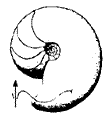 |
 Agoniatites Agoniatites
(Early Eifelian) |
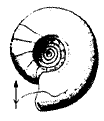 |
 Anarcestes Anarcestes
(late Emsian to
early Eifelian) |
MAK990322
Trilobites
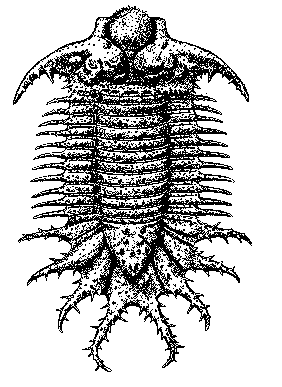
the magnificent giant trilobite Terataspis grandis (Hall)
50 cm long
Onondagan stage,
New York
MAK990322
page uploaded on Palaeos Site 10 June 2002
last modified ATW040717
checked ATW030616
(uploaded on Kheper Site on 22 March 1999)

Text by M. Alan Kazlev
Unless otherwise attributed, text on this page may be used under the terms of a
Creative Commons License.
 As always, when we are forced to use home-made graphics, the reader may correctly assume that there is something terribly wrong with the state of real knowledge in the area. There is no lack of Middle Devonian maps, but the degree of correspondence between them is extraordinarily poor. The basic facts of North American (Laurentian) and North European (Baltican) geography are well known. However, the position of the other continents, and the degree to which they lay above sea level, seems to be the subject of considerable dispute. We have therefore drawn a sort of compromise map. We strongly discourage anyone from taking it very seriously.
As always, when we are forced to use home-made graphics, the reader may correctly assume that there is something terribly wrong with the state of real knowledge in the area. There is no lack of Middle Devonian maps, but the degree of correspondence between them is extraordinarily poor. The basic facts of North American (Laurentian) and North European (Baltican) geography are well known. However, the position of the other continents, and the degree to which they lay above sea level, seems to be the subject of considerable dispute. We have therefore drawn a sort of compromise map. We strongly discourage anyone from taking it very seriously.






